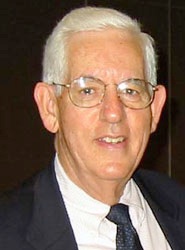2018
DUNCAN HERON LIFETIME ACHIEVEMENT AWARD

Robert “Bob” D. Hatcher
Dear Carolina Geological Society members,
It is my honor to nominate Dr. Robert D. Hatcher Jr., one of the Society’s longest current members, for the Duncan Heron Lifetime Achievement Award. Dr. Hatcher’s fifty-two-year career has made a profound impact on our understanding of the geology of the Carolinas through research, service, and teaching and mentoring several new generations of geologists (especially geologic mappers).
Although trained to map in sedimentary rocks in the Cumberland Plateau and Valley and Ridge of Tennessee, Dr. Hatcher first cut his crystalline rock teeth mapping in the Chauga belt of South Carolina, which resulted in his first Carolina Geological Society fieldtrip (1969), co-led with Villard Griffin. Dr. Hatcher expanded his field-based research into other parts of the Blue Ridge and Piedmont of North Carolina, South Carolina, Georgia, and Tennessee, and mountain belts beyond the Appalachians. His research examined a wide array of topics in the southern Appalachians from crustal-scale faults, large crystalline thrust sheets, lithotectonic terranes, geophysics, stratigraphy, and paleoseismicity. He published seminal papers on the Brevard fault zone (Hatcher, 1970, 2001; Hatcher et al. 2017), polyphase folding of the Toxaway dome (Hatcher, 1977), and the tectonics of the southern Appalachians (Hatcher, 1972, 1978, 1989; Hatcher et al., 2007). In total, he has published more than 200 scientific papers, ten books (including five textbooks), twelve geologic or tectonic maps, and over 470 presentation abstracts. He has led over 40 field trips for professional societies and meetings, including six Carolina Geological Society field trips—the most within the Society (1969, 1978, 1988, 1993, 2002, and 2005). Dr. Hatcher taught at four different universities, and directed 51 master’s theses and 17 Ph.D. dissertations, and mentored numerous undergraduates. Dr. Hatcher and his students combined have mapped nearly ninety-one 7.5-minute quadrangles. In addition, to serving as Vice-President (1974) and President (1975) of the Carolina Geological Society, Dr. Hatcher served the greater geologic community through various positions in boards, committees, and societies. Some of the more prominent positions include editor of the Geological Society of America Bulletin (1981–1988), President of the Geological Society of America, and President of the American Geological Institute (AGI) (1995– 1996). He has received numerous awards for his research and service, among them the John T. Galey Award (American Association of Petroleum Geologists, 2011), Ian Campbell Medal (AGI, 2006), Penrose Medal (GSA, 2006), and the Marcus Milling Legendary Geoscientist Medal (AGI, 2014).
Dr. Hatcher’s career is an impressive half-century of research and geologic mapping, continued service to the greater geologic community, and teaching and mentoring graduate and undergraduate students. He has remained a constant advocate for geologic mapping and field research and has profound effect on our understanding of the geology of the Carolinas, as well as the southern Appalachians. Dr. Hatcher and his career contributions exemplify the qualities and dedication of the Duncan Heron Lifetime Achievement Award and I here nominate him for the award.
Sincerely,
Arthur J. Merschat, Ph.D.
Research Geologist
U.S. Geological Survey
Carolina Geological Society, Vice-President (2018)
_______________________________________________________________________
References Cited (*indicates relevant publication submitted for review)
Hatcher, R. D., Jr., 1970, Stratigraphy of the Brevard zone and Poor Mountain area, northwestern South Carolina: Geological Society of America Bulletin, v. 81, p. 933–940.
Hatcher, R. D., Jr., 1971, Structural, petrologic, and stratigraphic evidence favoring a thrust solution to the Brevard problem: American Journal of Science, v. 270, p. 177–202.
Hatcher, R. D., Jr., 1972, Developmental model for the southern Appalachians: Geological Society of America Bulletin, v. 83, p. 2735–276.*Hatcher, R. D., Jr., 1977, Macroscopic polyphase folding illustrated by the Toxaway Dome, eastern Blue Ridge, South Carolina–North Carolina: Geological Society of America Bulletin, v. 88, p. 1678– 1688
Hatcher, R. D., Jr., 1978, Tectonics of the western Piedmont and Blue Ridge: Review and speculation: American Journal of Science, v. 278, p. 276–304.
*Hatcher, R. D., Jr., 1980, Geologic map and mineral resources of the Prentiss quadrangle, North Carolina: North Carolina Geological Survey, GM 167–SW, scale 1/24,000.
Hatcher, R. D., Jr., 1989, Tectonic synthesis of the U.S. Appalachians, Chapter 14, in Hatcher, R. D., Jr., Thomas, W. A., and Viele, G. W., eds., The Appalachian–Ouachita orogen in the United States: Boulder, Colorado, Geological Society of America, The Geology of North America, v. F–2, p. 511– 535.
Hatcher, R. D., Jr., 2001, Rheological partitioning during multiple reactivation of the Paleozoic Brevard fault zone, southern Appalachians, USA, in Holdsworth, R. E., Strachan, R. A., Magloughlin, J. F., and Knipe, R. J., eds., The nature and tectonic significance of fault zone weakening: London, Geological Society of London Special Publication 186, p. 255-269.
Hatcher, R. D., Bream, B. R., and Merschat, A. J., 2007, Tectonic map of the southern and central Appalachians: A tale of three orogens and a complete Wilson cycle, in Hatcher, R. D., Jr., Carlson, M. P., McBride, J. H., and Martinez Catalan, J. R., eds., 4–D Framework of Continental Crust: Geological Society of America Memoir 200, p. 595–632.
*Hatcher, R. D., Jr., Huebner, M. T., Rehrer, J. R., Acker, L.L., Fullagar, P. D., Liu, A., and Goad, P. L., 2017, Geologic and kinematic insights from far-traveled horses in the Brevard fault zone, southern Appalachians, in Law, R. D., Stowell, H. T., and Thigpen, J. R., eds., Linkages and Feedbacks in Orogenic Processes: Geological Society of America Memoir 213, p. 313-351